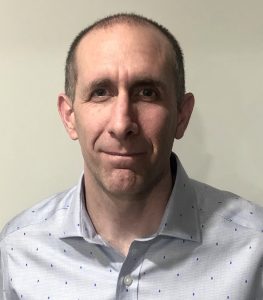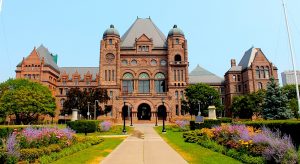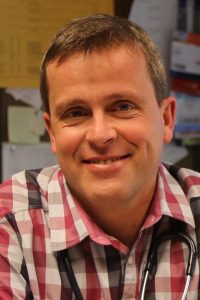Study investigates the association between muscles and ILD

A recent UBC study of 115 people with Interstitial Lung Disease (IDL), including 40 people with Idiopathic Pulmonary Fibrosis (IPF) found a significant association between the severity of ILD and breathlessness, with muscle mass, strength and performance.
Co-principal investigators Dr. Christopher Ryerson and Dr. Sabina Guler, a post-doctoral fellow at UBC, conducted the research with a $20,000 research grant from the Canadian Pulmonary Fibrosis Foundation for 2018-2019 as well as funding from the British Columbia Lung Association.
“While previous studies have been done with animals and some in vitro (out of body) human blood and tissues suggesting associations between muscular health and IPF, this is the first time a study has been conducted involving with people with ILD, outside of the lab,” says Dr. Ryerson.
Study participants were assessed for their disease severity and muscle mass. They also undertook walk and grip tests. The association between the disease and muscle mass and function is just the first step involving patients in this area of research.

“Although we have demonstrated an association, it’s a chicken and egg question of which occurs first,” says Dr. Ryerson. “ILD frequently leads to inactivity and muscle weakening as people avoid the discomfort of breathlessness brought on by physical activity. Or, it is possible the disease itself, with its risk factors for muscle disease, including alterations in sex and growth hormones, leads to muscle deterioration. Of course, it could also be a combination of the two, or other factors entirely. These are the next research questions we need to explore.”
According to the study’s authors, this study’s results do have potential implications for the design of exercise training programs for patients with ILD. Individualized exercise programs, which provide enough muscle stimulation, prior to the onset of breathlessness, may improve muscle performance.
The CPFF research grant was very important for this project. “In addition to adding to our knowledge of ILD, this research project involved post-doctoral fellow Dr. Sabina Guler of Switzerland,” says Dr. Ryerson. “Although she has returned to Switzerland, she is continuing this research, opening an avenue for international collaboration and wider dissemination of this work.”
Dr. Guler presented the study results at recent meeting of the European Respiratory Society. The study has also been published in the journal Respiratory Research. You can read the journal article by visiting pubmed.com. Type 30866948 in the search bar. This will bring up the abstract of the article. A link near the end of the abstract titled “Free PMC Article” will take you to the full article.
For more information about exercise and pulmonary fibrosis, visit our website page Rehab and Exercise, which includes an exercise video for people living with PF.
Invite your MPP to attend CPFFs first Queen’s Park event

With the Ontario legislature returning to Queen’s Park after the federal election, the Canadian Pulmonary Fibrosis Foundation (CPFF) is gearing up to present MPPs and government policy makers with a new report and recommendations to improve the lives of Ontario residents living with pulmonary fibrosis.
On December 4, 2019, patients, caregivers and representatives of CPFF have appointments to meet with a number MPPs to tell them about CPFF and discuss how we can help the government to provide quality care to our Community more efficiently and cost effectively, for the benefit of both taxpayers and patients.
Late in the day, CPFF will host a reception for any MPPs interested in learning about pulmonary fibrosis and solving the current challenges faced by those living with the disease. If you are an Ontario resident, we are asking for your help with this initiative. CPFF has created a sample email invitation that you can send to your MPP inviting them to attend the session on December 4. You can also find a list of Ontario MPPs, with their email addresses and ridings, and whether or not they have already responded to our invitation. If they have responded, please do NOT send another invitation. If they have not responded, please send them your invitation, as soon as possible, so they can fit it into their calendar.
If the MPP responds to you directly, rather than RSVP to Puneet as directed in the invitation, please forward their response to [email protected].
During the meetings throughout this lobbying day, “we will highlight concerns of the community, aligning our requests for government support with the objectives of the current government, for the best chance at success,” says Sharon Lee, Executive Director of CPFF.
This endeavour will become a model for approaching other provincial governments and the federal government to help ensure equal access to quality care, and an improved quality of life, for Canadians living with pulmonary fibrosis.
CPFF will be making use of data and recommendations in a new national report when presenting its case to the Ontario government decision-makers. The report, set for release later this month, provides an overview of the burden of IPF – both from the patients’ and support partners’ standpoint on the impacts to their health, and also a quantification of the economic burden that results from diagnostic delays and treatment challenges. It also highlights important disparities in treatment across Canada, which may affect the quality of care that patients receive simply based on where they live. Once complete, the report will be available on our website.
Update with CPFF sponsor Boehringer Ingelheim Canada

The Canadian Pulmonary Fibrosis Foundation regularly meets with its corporate sponsors, including Boehringer Ingelheim Canada, to exchange information and discuss how sponsorship funds can be used to assist people living with pulmonary fibrosis.
Last month CPFF Executive Director Sharon Lee met with employees at Boehringer Ingelheim to update them on the Foundation’s plans. Her presentation also outlined the CPFFs recent successes during Pulmonary Fibrosis Month, including meetings with elected officials and government representatives, as well as education, awareness and fundraising events.
She outlined our continued commitment to our four pillars of patient and caregiver support; education and awareness; research; and advocacy. She shared our plans for an advocacy day at Queen’s Park in Toronto on December 4, when CPFF will host a reception for MPPs and spend the day meeting with Ontario’s provincial elected officials and staffers. (Read the previous article for more details on this advocacy initiative.)
The Foundation is also planning to conduct a community survey to probe areas of concern for people living with pulmonary fibrosis and their caregivers, as well as assess areas of concern for health care providers. It will also help us understand the public perception of the disease and the role of CPFF, including perception and donation intentions.
To close the meeting, Boehringer Ingelheim employees gathered together to show their support for CPFF’s participation in the Scotiabank Charity Challenge, a fundraising event held in Toronto on October 20. The 17-member CPFF team raised more than $9,000 for the cause at the event.
Clinical trial results offer encouraging news for people with other ILDs

An October 9, 2019 news release from Boehringer Ingelheim, announced the results of a study that demonstrated the efficacy and safety of nintedanib (OFEV®) in patients with a broad range of progressive fibrosing interstitial lung diseases (ILDs) other than idiopathic pulmonary fibrosis (IPF).
“Patients suffering from different interstitial lung diseases or ILDs have variable, often irreversible damage to their lungs with a poor prognosis. Unfortunately, to date there are no medications approved for the treatment of progressive fibrosing ILDs, except for IPF,” explained
Dr. Martin Kolb, a member of CPFF’s Medical Advisory Board and the Director, Division of Respirology, Department of Medicine, McMaster University.
“The recent results of the INBUILD trial identified conclusively that OFEV slowed the decline of pulmonary function in patients who suffer from progressive pulmonary fibrosis, across the ILD spectrum,” states Dr. Kolb in the news release.
The study was recently published in the New England Journal of Medicine and presented at the European Respiratory Society Congress in Madrid, Spain.
“We are always pleased to learn of potential new treatment options,” says Sharon Lee, CPFF Executive Director, “in this case, for people with ILDs other than IPF.”
November is Make A Will Month: Do you have one?

It’s never too early to start estate planning. And you should update your Will after any major life event, such as a birth, divorce, death or changes to your health or financial status.
Our Founder Robert Davidson, who passed away in May this year, took his own advice to heart and left a bequest to CPFF in his Will. He wrote about the importance of creating or updating your Will in the December 2018 issue of our newsletter and stressed the need to discuss it with your family, so they are not surprised when your Will is read.
Without proper estate planning, you will not be able to influence how, when, and to whom your assets will be distributed after you pass. If you don’t have a Will, then gifts to specific individuals or to charitable organizations will not occur and a provincial or territorial government can appoint someone to decide what happens to your savings and property.
A good place to start is to think about your assets and how you want to divide them amongst your family members and friends. It’s important that you keep your original Will in a safe place, and a copy at home. Only an original Will—no photocopies—can be shown in court. Usually a Will is kept by the client in a safety deposit box, or by the lawyer. There have been cases where the original Will wasn’t presented and the judge revoked the wishes of the deceased, so make sure people know where the original is being kept.
Making a Will isn’t hard or overly expensive—it could cost $1,000 or more depending on the complexity of the document and how much your lawyer charges per hour. But whatever the cost, it’s worth it. You don’t want a judge deciding the fate of your estate.
If leaving a gift in your Will to the Canadian Pulmonary Fibrosis Foundation (CPFF) is something you would like to consider, we would be pleased to speak with you in confidence to explore your options.
Benefits to you by making a gift to charity in your Will
- Convenient: It can be made regardless of your age and for any amount.
- Cost effective: Your present income will not decrease.
- Simple: It is easy to arrange. Simply instruct your lawyer to include a gift to the Canadian Pulmonary Fibrosis Foundation in your Will. It can be a specific amount, a percentage of your estate, or the residue of your estate (a gift after debts have been paid and other gifts have been distributed.)
- Tax relief: Your estate will receive a charitable tax receipt which can be used to reduce taxes on your final tax return and, in some cases, the previous year’s tax return.
Benefits to CPFF and the people you help
- Helping people with Pulmonary Fibrosis: Your gift will enable us to provide education and support services, and advocate on behalf of Canadians living with pulmonary fibrosis.
- Investing in a cure: Your gift will also provide funding for innovative research, expanding our knowledge about early symptoms, diagnosis and treatments for pulmonary fibrosis, and ultimately bring us closer to a cure.
If you would like to discuss leaving a gift in your Will to the Canadian Pulmonary Fibrosis Foundation (CPFF) please contact Sharon Lee at [email protected] to arrange to speak to her in confidence to explore your options.
Our adventure from diagnosis to double-lung transplant
By Dave Wotton

In January 2017 a routine chest x-ray before my first knee replacement surgery, found scarring on my lower lungs and I was referred to respirologist Dr. L. Homik for future follow-up. In late October 2017, following several months of testing, including two CAT scans, I was diagnosed with idiopathic pulmonary fibrosis (IPF). I was told that it was a progressive disease with no cure other than a lung transplant, which was not generally considered for those over 65. I was turning 69 that November. I did learn that there were two anti-fibrotic medications that could slow the disease progression. I began treatment with Pirfenidone (Esbriet) in mid-November, hoping that it would slow the disease beyond its two to three-year prognosis.
My wife Pat and I were in a state of shock for the next few months. We had a difficult time believing the diagnosis and explaining the prognosis to our family or close friends, never mind remembering that “idiopathic” meant cause unknown. In my case, I suspect it was associated with my initial position as a Forest / Environment Research Scientist for the Province of Manitoba from 1976-1990. I studied the effects of airborne pollution from mining smelters, chemical plants, lead in urban soils, contaminated sites, wood preservative plants and other hazardous waste on trees, vegetation and soils.
We were fortunate that an IPF support group had just been organized in Winnipeg and in January 2018 we were able to meet and share our stories with others diagnosed with the disease and their support persons at regular meetings. We became faithful attendees and thoroughly enjoyed the hospitality, speakers and interaction with other members at various stages of IPF. This was particularly beneficial for understanding and coming to grips with the disease. I experienced very few symptoms through the first 11 months of 2018 and in July we booked a trip to New Zealand for January 2019 and at our favorite resort on Vancouver Island for April 2019. Unfortunately, both vacations had to be cancelled due to the progression of the disease.
I had always been an active person biking, swimming and walking and knew I had to keep active to keep my lungs as healthy as possible. In June 2018, I underwent my second knee replacement surgery and I came through the operation well. I was determined to fight IPF, but I got too aggressive with my physiotherapy over the summer and ended up having to undergo a second surgery for a hernia in mid-September. In early October, I was able to join the first respiratory rehabilitation program for those with IPF in the province. Unfortunately, by the end of the eight-week program my breathing was deteriorating and I was prescribed home oxygen for times of exertion, such as exercise and outdoor walking. The IPF symptoms continued to increase and in mid-January 2019, I was recommended for a Lung Transplant Assessment. I was cautioned that I may meet resistance because I just turned 70 and some centres preferred not to accept people over 65. My alternative was planning for palliative care sometime in the not- so-distant future.
In Manitoba the lung transplant team at the Health Sciences Centre Hospital in Winnipeg works cooperatively with the lung transplant team at the University of Alberta Hospital in Edmonton. The assessment process takes place in Winnipeg and the surgery, if approved, takes place in Edmonton. The process took about four months and included more than 30 medical tests and interviews. I was successful in being approved by the Manitoba team in late May because I had kept myself active throughout my life and was in reasonably good shape. This was followed by presentation of my final results and approval for listing as a transplant candidate by the lung transplant team at University of Alberta’s Hospital in early June 2019.
My IPF was accelerating throughout this assessment process and in mid-June I experienced a lung infection leading to pneumonia. This resulted in a serious decline of my strength to where I could barely walk. I persevered through Father’s Day with our family on June 16 and the next day, as a precaution, we met with our funeral director to ensure we had our end of life plans in place for both Winnipeg and Edmonton. Later that same day, I had to be rushed by ambulance to the Health Sciences Centre in very serious condition. I remained in hospital for just over two weeks and was flown by Air Ambulance to Edmonton on July 5. My health had deteriorated significantly and the flight was not an easy one, however we were accompanied by excellent medical support and made the two-hour flight successfully. I was matched to lungs on July 6 and underwent a double lung transplant July 7. Following the eight-hour surgery the surgeon explained to Pat that all went well, but looking at my old lungs he thought I may only have had seven days of life left. I spent a further two weeks in Edmonton, returned to the Health Sciences Centre in Winnipeg for two more weeks and to date I am very fortunate to have had a successful recovery.
It truly was a miracle in timing and in recovery as I have had very little difficulty and it has now been three months since the operation. The recovery process is rigorous and ongoing with regular visits to the respiratory clinic for balancing medication, bloodwork and other medical tests, as well as physiotherapy, all of which are critical. I had lost a lot of strength during my six weeks in hospital and had to learn to walk again. Physiotherapy was key and I can now use the treadmill and stationary bike for over 30 minutes, as well as walk Rufus, our 100-lb. dog for 30 minutes. My new lungs are functioning well and although healing is slow and steady, we are again able to enjoy quality of life with our family, our friends and make plans for the future.
I would like to take this opportunity to commend the lung transplant teams from both the Health Sciences Centre and the University of Alberta for the exceptional quality of health care provided to me before and after this difficult surgery. My wife and support person Pat and I were consistently inspired by the professional and personal attention and commitment to excellence in health care that we received throughout our experience. The team members were welcoming, friendly and respectful. It was a true team effort as they conducted their professional duties from the beginning in preparing us for the operation to medically following the surgery. They continue to do so in our post-operation clinics and physiotherapy. We felt that we were breaking new ground by being one of the first people over 70 to successfully meet all the requirements of the assessment process, as well as being supported by both lung transplant teams in Manitoba and Alberta. We understand that this may help to set a new protocol and may lead to others over 65 with IPF receiving this life-saving opportunity.
I will always be thankful and will never forget the lifesaving gift of the donor and their family. The importance of organ donation has been a wake-up call to our immediate and extended family, as well as our friends and their contacts. Our oldest granddaughter in her early 20’s recently posted to her friends and contacts that for her birthday on August 25 she only requests one gift, that everyone registers for organ donation. Our other three granddaughters and family members have also registered as well. The gift of life is cherished with every breath!
IPF is a most difficult disease for the individual and their family. Pat and I gratefully appreciate the work and support of the Canadian Pulmonary Fibrosis Foundation and their volunteers in their communication, education, research and fight for a cure.
Editor’s note: You can read more personal stories on our website here. This article has been edited for this publication.


